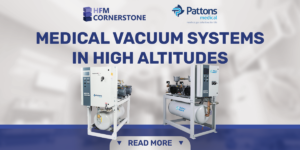A mistake often missed that we see within drawings is the cutting and pasting of specs. Pattons Medical Master Specification Guide has choices that you can make per project. If you use that as a base, you are able to go in and save as project name and then make it custom to each specific project. Pattons Medical does spec reviews where we sit down and go by section so that you have a good understanding of what’s in your spec and why.
Medical gas alarms are a source of confusion at times, for example, the difference between a master alarm panel, an area alarm, and a combo alarm.
Master alarm panels monitor the source equipment only, and two are required in a category one facility. Area alarm panels monitor the area that goes with the zone valve. You will often find a combo alarm in smaller facilities, and that’s when a master alarm is needed on the wall with an area alarm panel, but they still don’t communicate with each other. The area alarm modules are on the top and master alarm modules are on the bottom, and they have separate functions. The wiring and details for that are site or project specific.

Another commonly missed or assumed on projects is ethernet/back net capability. Often times facilities would like their equipment to talk to their building information system (BAS) and you can do that with an ethernet port. If their BAS has specific back net language, then we can do that with a back net port. Our recommendation, and the most cost effective, is to hook one master alarm panel, and set it up with an ethernet/back net capability and hook that to the building automation system, that way you are capturing all the alarms that are going to that master alarm panel and sending those watts to the BAS.
It’s good to ask questions about the facility;
Is your vacuum system located at a high elevation?
Do we need to look at different vacuum technologies because of the elevation concerns?
What vacuum technology is going to be the best fit for a smaller facility that doesn’t have a maintenance team on staff?
Do you want to pay for somebody to come and change out the oil every three months or would a dry vacuum technology be better for you?
Our medical gas experts can help you with determine the best vacuum technology for your facility while taking in all different factors into consideration. Pattons Medical also offers a an air and vacuum sizing calculator that can provide guidance on which medical vacuum is best suited for your facility.





